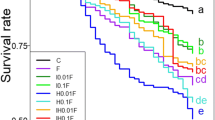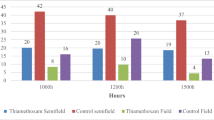Abstract
Three insect growth regulators were applied topically on the 3-day old larvae of carniolan honeybee workers in their own cells. The high and intermediate lethal doses (LD90 and LD50) from each of three tested IGR's (Triflumuron, Chlorfluazuron and Diflubenzuron) had a “Removal-lethal” effect on treated larvae. Thus, neither sealed brood nor adult workers were obtained from IGR's — treated-larvae. While latent inhibitory action of the lower lethal dose (LD25) of all tested IGR's showing a remarkable significant decrease in body weights of newly emerged workers, resulting from IGR's-treated-larvae.
The differences between the effect of tested IGR's on the workers weights were significant. The tested IGR's could be arranged in descending order according to their reducing effect on workers weights as follows: Triflumuron, Chlorfluozuron and Diflubenzuron.
Zusammenfassung
Die Applikation der drei Insektenwachstumshemmstoffe (IGRs) Triflumuron, Chlorfluazuron und Diflubenzuron bei 3 Tage alten Larven dercarnica-Rasse der Honigbiene hatte in den LD 50- und LD 90-Dosen eine „Entfernungsletalwirkung”: die Ammenbienen entfernten die behandelten Larven, so daß aus diesen keine Arbeitsbienen entstanden, deren Gewicht hätte bestimmt werden können. Dagegen entwickelten sich die mit den LD 25-Dosen der 3 IGRs behandelten Larven zu Arbeiterinnen, deren Gewicht gegenüber Kontrolle i. M. um 39,6% (Triflumuron), — 29,1% (Chlorfluazuron) sowie 19,3% (Diflubenzuron) vermindert war.
Similar content being viewed by others
Literaturverzeichnis
Abbott, W. S., 1925: A method of computing the effectiveness of an insecticide. J. econ. Ent.18 (2), 265–269.
Anderson, L. D.;Atkins, E. L. Jr, 1958: Toxicity of pesticides to honeybees in laboratory and field tests in southern California, 1955–1956. J. econ. Ent.51 (1), 103–108.
Anderson, L. D.;Atkins, E. L. Jr, 1968: Pesticide usage in relation to beekeeping. Ann. Rev. Ent.13, 213–238.
Arnold, A. J., 1967: Hand operated micro-applicator to deliver drops of fine sizes. Lab. practice16 (1), 56–57.
Atkins, E. L. Jr;Kellum, D., 1986: Comparative morphogenic and toxicity studies on the effect of pesticides on honey bee brood. J. apic. Res.25 (4), 242–255.
Barker, R. J.;Taber, S., 1977: Effects of Diflubenzuron fed to caged honeybees. Env. Ent.6 (1), 167–168.
Copijn, G. M.;Beetsma, J.;Writz, P., 1979: Queen differentiation and mortality after application of different juvenile hormone analogues to worker larvae of honeybee,Apis mellifera L. In proc. koninklijke Nederlands Akad. wetenschappen, series C,82 (1), 29–42.
El-Haddad, N. D., 1977: Studies on queen honeybee rearing. M. Sc. Thesis, Fac. Agric., Alexandria Univ., Alexandria, Egypt, 75 pp.
Finney, D. J., 1952: Probit analysis, statistical treatment of sigmoid response curve. Cambridge Univ. Press, London, New York.
Moffett, J. O.;Wilson, W. J.;Stoner, A.;Wordecker, A., 1979: Effect of fifteen combinations of flour management methods on losses of honeybees caused by spraying insecticides on cotton. J. econ. Ent.72 (3), 453–455.
Rembold, H.;Czoppelt, C.;Rao, P. J., 1974: Effect of juveline hormone treatment on caste differentation in the honeybees,Apis mellifera. J. Insect physiol.20, 1193–1202.
Stoner, A.;Wilson, W. T., 1982: Diflubenzuron (Dimilin): effect of long-term feeding of low doses in sugar-cake or sucros syrup on honeybees in standard-size field colonies. Am. Bee J.122, 579–582.
Author information
Authors and Affiliations
Additional information
Mit einer Tabelle
Rights and permissions
About this article
Cite this article
El-Din, H.A.S., El-Samni, M.A. & Attia, M.B. Über latente Wirkungen einiger Insektenwachstumsregeler auf das Körpergewicht von Arbeiterinnen der HonigbieneApis mellifera L. var.Carnica (Hym., Apidae). Anz. Schadlingskde., Pflanzenschutz, Umweltschutz 63, 67–68 (1990). https://doi.org/10.1007/BF01909004
Issue Date:
DOI: https://doi.org/10.1007/BF01909004




